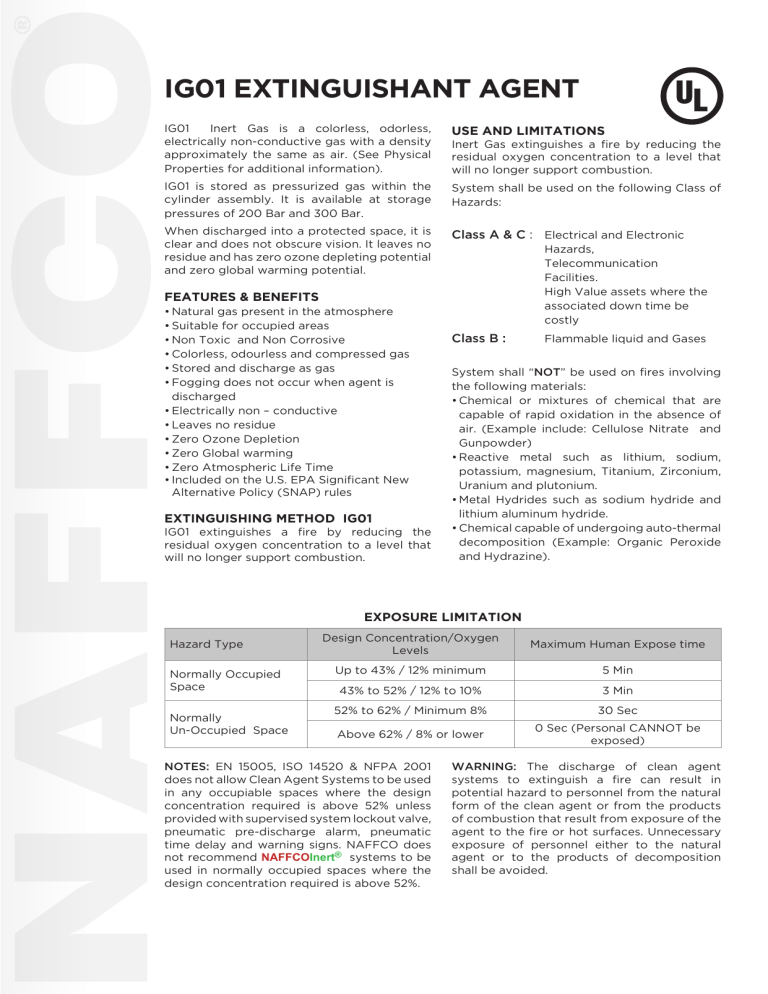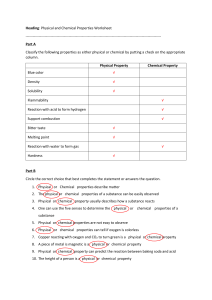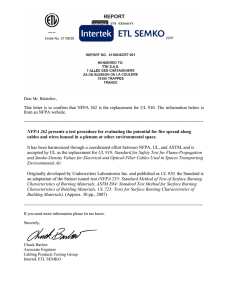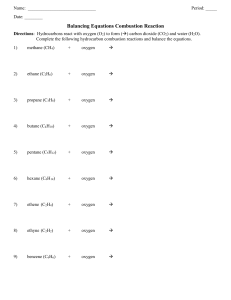
IG01 EXTINGUISHANT AGENT IG01 Inert Gas is a colorless, odorless, electrically non-conductive gas with a density approximately the same as air. (See Physical Properties for additional information). USE AND LIMITATIONS IG01 is stored as pressurized gas within the cylinder assembly. It is available at storage pressures of 200 Bar and 300 Bar. System shall be used on the following Class of Hazards: When discharged into a protected space, it is clear and does not obscure vision. It leaves no residue and has zero ozone depleting potential and zero global warming potential. Class A & C : Electrical and Electronic FEATURES & BENEFITS • Natural gas present in the atmosphere • Suitable for occupied areas • Non Toxic and Non Corrosive • Colorless, odourless and compressed gas • Stored and discharge as gas • Fogging does not occur when agent is discharged • Electrically non – conductive • Leaves no residue • Zero Ozone Depletion • Zero Global warming • Zero Atmospheric Life Time • Included on the U.S. EPA Significant New Alternative Policy (SNAP) rules EXTINGUISHING METHOD IG01 IG01 extinguishes a fire by reducing the residual oxygen concentration to a level that will no longer support combustion. Inert Gas extinguishes a fire by reducing the residual oxygen concentration to a level that will no longer support combustion. Hazards, Telecommunication Facilities. High Value assets where the associated down time be costly Class B : Flammable liquid and Gases System shall “NOT” be used on fires involving the following materials: • Chemical or mixtures of chemical that are capable of rapid oxidation in the absence of air. (Example include: Cellulose Nitrate and Gunpowder) • Reactive metal such as lithium, sodium, potassium, magnesium, Titanium, Zirconium, Uranium and plutonium. • Metal Hydrides such as sodium hydride and lithium aluminum hydride. • Chemical capable of undergoing auto-thermal decomposition (Example: Organic Peroxide and Hydrazine). EXPOSURE LIMITATION Hazard Type Normally Occupied Space Normally Un-Occupied Space Design Concentration/Oxygen Levels Maximum Human Expose time Up to 43% / 12% minimum 5 Min 43% to 52% / 12% to 10% 3 Min 52% to 62% / Minimum 8% 30 Sec Above 62% / 8% or lower 0 Sec (Personal CANNOT be exposed) NOTES: EN 15005, ISO 14520 & NFPA 2001 does not allow Clean Agent Systems to be used in any occupiable spaces where the design concentration required is above 52% unless provided with supervised system lockout valve, pneumatic pre-discharge alarm, pneumatic time delay and warning signs. NAFFCO does not recommend NAFFCOInert® systems to be used in normally occupied spaces where the design concentration required is above 52%. WARNING: The discharge of clean agent systems to extinguish a fire can result in potential hazard to personnel from the natural form of the clean agent or from the products of combustion that result from exposure of the agent to the fire or hot surfaces. Unnecessary exposure of personnel either to the natural agent or to the products of decomposition shall be avoided. PHYSICAL PROPERTIES OF IG-01 Chemical Name Molecular Weight Boiling Point at 1.013 Bar Critical Pressure Critical Temperature Design Concentration for Class A Fire (NFPA) Flooding Factor for Class A Fire (NFPA) Ar 39.9 -185.9°C 49 Bar -122.3°C 38.7% 0.481 m³/ m³ NOAEL 43% LOAEL 53% IG100 EXTINGUISHANT AGENT IG100 Inert Gas is a colorless, odorless, electrically non-conductive gas with a density approximately the same as air. (See Physical Properties for additional information). USE AND LIMITATIONS IG100 is stored as pressurized gas within the cylinder assembly. It is available at storage pressures of 200 Bar and 300 Bar. System shall be used on the following Class of Hazards: When discharged into a protected space, it is clear and does not obscure vision. It leaves no residue and has zero ozone depleting potential and zero global warming potential. Class A & C : Electrical and Electronic FEATURES & BENEFITS • Natural gas present in the atmosphere • Suitable for occupied areas • Non Toxic and Non Corrosive • Colorless, odourless and compressed gas • Stored and discharge as gas • Fogging does not occur when agent is discharged • Electrically non – conductive • Leaves no residue • Zero Ozone Depletion • Zero Global warming • Zero Atmospheric Life Time • Included on the U.S. EPA Significant New Alternative Policy (SNAP) rules EXTINGUISHING METHOD IG100 IG100 extinguishes a fire by reducing the residual oxygen concentration to a level that will no longer support combustion. Inert Gas extinguishes a fire by reducing the residual oxygen concentration to a level that will no longer support combustion. Hazards, Telecommunication Facilities. High Value assets where the associated down time be costly Class B : Flammable liquid and Gases System shall “NOT” be used on fires involving the following materials: • Chemical or mixtures of chemical that are capable of rapid oxidation in the absence of air. (Example include: Cellulose Nitrate and Gunpowder) • Reactive metal such as lithium, sodium, potassium, magnesium, Titanium, Zirconium, Uranium and plutonium. • Metal Hydrides such as sodium hydride and lithium aluminum hydride. • Chemical capable of undergoing auto-thermal decomposition (Example: Organic Peroxide and Hydrazine). EXPOSURE LIMITATION Hazard Type Normally Occupied Space Normally Un-Occupied Space Design Concentration/Oxygen Levels Maximum Human Expose time Up to 43% / 12% minimum 5 Min 43% to 52% / 12% to 10% 3 Min 52% to 62% / Minimum 8% 30 Sec Above 62% / 8% or lower 0 Sec (Personal CANNOT be exposed) NOTES: EN 15005, ISO 14520 & NFPA 2001 does not allow Clean Agent Systems to be used in any occupiable spaces where the design concentration required is above 52% unless provided with supervised system lockout valve, pneumatic pre-discharge alarm, pneumatic time delay and warning signs. NAFFCO does not recommend NAFFCOInert® systems to be used in normally occupied spaces where the design concentration required is above 52%. WARNING: The discharge of clean agent systems to extinguish a fire can result in potential hazard to personnel from the natural form of the clean agent or from the products of combustion that result from exposure of the agent to the fire or hot surfaces. Unnecessary exposure of personnel either to the natural agent or to the products of decomposition shall be avoided. PHYSICAL PROPERTIES OF IG - 100 Chemical Name N² Molecular Weight 28 Boiling Point at 1 ATM (1.013 Bar) -196°C Critical Pressure 40 Bar Critical Temperature Design Concentration for Class A Fire (NFPA) Flooding Factor for Class A Fire (NFPA) -146.9°C 37.2% 0.457 m³/ m³ NOAEL 43% LOAEL 53% IG55 EXTINGUISHANT AGENT IG55 Inert Gas is a colorless, odorless, electrically non-conductive gas with a density approximately the same as air. (See Physical Properties for additional information). USE AND LIMITATIONS IG55 is stored as pressurized gas within the cylinder assembly. It is available at storage pressures of 200 Bar and 300 Bar. System shall be used on the following Class of Hazards: When discharged into a protected space, it is clear and does not obscure vision. It leaves no residue and has zero ozone depleting potential and zero global warming potential. Class A & C : Electrical and Electronic FEATURES & BENEFITS • Natural gas present in the atmosphere • Suitable for occupied areas • Non Toxic and Non Corrosive • Colorless, odourless and compressed gas • Stored and discharge as gas • Fogging does not occur when agent is discharged • Electrically non – conductive • Leaves no residue • Zero Ozone Depletion • Zero Global warming • Zero Atmospheric Life Time • Included on the U.S. EPA Significant New Alternative Policy (SNAP) rules EXTINGUISHING METHOD IG55 IG55 extinguishes a fire by reducing the residual oxygen concentration to a level that will no longer support combustion. Inert Gas extinguishes a fire by reducing the residual oxygen concentration to a level that will no longer support combustion. Hazards, Telecommunication Facilities. High Value assets where the associated down time be costly Class B : Flammable liquid and Gases System shall “NOT” be used on fires involving the following materials: • Chemical or mixtures of chemical that are capable of rapid oxidation in the absence of air. (Example include: Cellulose Nitrate and Gunpowder) • Reactive metal such as lithium, sodium, potassium, magnesium, Titanium, Zirconium, Uranium and plutonium. • Metal Hydrides such as sodium hydride and lithium aluminum hydride. • Chemical capable of undergoing auto-thermal decomposition (Example: Organic Peroxide and Hydrazine). EXPOSURE LIMITATION Hazard Type Normally Occupied Space Normally Un-Occupied Space Design Concentration/Oxygen Levels Maximum Human Expose time Up to 43% / 12% minimum 5 Min 43% to 52% / 12% to 10% 3 Min 52% to 62% / Minimum 8% 30 Sec Above 62% / 8% or lower 0 Sec (Personal CANNOT be exposed) NOTES: EN 15005, ISO 14520 & NFPA 2001 does not allow Clean Agent Systems to be used in any occupiable spaces where the design concentration required is above 52% unless provided with supervised system lockout valve, pneumatic pre-discharge alarm, pneumatic time delay and warning signs. NAFFCO does not recommend NAFFCOInert® systems to be used in normally occupied spaces where the design concentration required is above 52%. WARNING: The discharge of clean agent systems to extinguish a fire can result in potential hazard to personnel from the natural form of the clean agent or from the products of combustion that result from exposure of the agent to the fire or hot surfaces. Unnecessary exposure of personnel either to the natural agent or to the products of decomposition shall be avoided. PHYSICAL PROPERTIES OF IG - 55 Chemical Name Molecular Weight N²/Ar 33.95 Boiling Point at 760 mm Hg -190.1ºC Critical Pressure 602 psia Critical Temperature -134.7ºC Design Concentration for Class A Fire (NFPA) Flooding Factor for Class A Fire (NFPA) 37.2% 0.457 m³/ m³ NOAEL 43% LOAEL 52% IG541 EXTINGUISHANT AGENT IG541 Inert Gas is a colorless, odorless, electrically non-conductive gas with a density approximately the same as air. (See Physical Properties for additional information). USE AND LIMITATIONS IG541 is stored as pressurized gas within the cylinder assembly. It is available at storage pressures of 200 Bar and 300 Bar. System shall be used on the following Class of Hazards: When discharged into a protected space, it is clear and does not obscure vision. It leaves no residue and has zero ozone depleting potential and zero global warming potential. Class A & C : Electrical and Electronic FEATURES & BENEFITS • Natural gas present in the atmosphere • Suitable for occupied areas • Non Toxic and Non Corrosive • Colorless, odourless and compressed gas • Stored and discharge as gas • Fogging does not occur when agent is discharged • Electrically non – conductive • Leaves no residue • Zero Ozone Depletion • Zero Global warming • Zero Atmospheric Life Time • Included on the U.S. EPA Significant New Alternative Policy (SNAP) rules EXTINGUISHING METHOD IG541 IG541 extinguishes a fire by reducing the residual oxygen concentration to a level that will no longer support combustion. Inert Gas extinguishes a fire by reducing the residual oxygen concentration to a level that will no longer support combustion. Hazards, Telecommunication Facilities. High Value assets where the associated down time be costly Class B : Flammable liquid and Gases System shall “NOT” be used on fires involving the following materials: • Chemical or mixtures of chemical that are capable of rapid oxidation in the absence of air. (Example include: Cellulose Nitrate and Gunpowder) • Reactive metal such as lithium, sodium, potassium, magnesium, Titanium, Zirconium, Uranium and plutonium. • Metal Hydrides such as sodium hydride and lithium aluminum hydride. • Chemical capable of undergoing auto-thermal decomposition (Example: Organic Peroxide and Hydrazine). EXPOSURE LIMITATION Hazard Type Normally Occupied Space Normally Un-Occupied Space Design Concentration/Oxygen Levels Maximum Human Expose time Up to 43% / 12% minimum 5 Min 43% to 52% / 12% to 10% 3 Min 52% to 62% / Minimum 8% 30 Sec Above 62% / 8% or lower 0 Sec (Personal CANNOT be exposed) NOTES: EN 15005, ISO 14520 & NFPA 2001 does not allow Clean Agent Systems to be used in any occupiable spaces where the design concentration required is above 52% unless provided with supervised system lockout valve, pneumatic pre-discharge alarm, pneumatic time delay and warning signs. NAFFCO does not recommend NAFFCOInert® systems to be used in normally occupied spaces where the design concentration required is above 52%. WARNING: The discharge of clean agent systems to extinguish a fire can result in potential hazard to personnel from the natural form of the clean agent or from the products of combustion that result from exposure of the agent to the fire or hot surfaces. Unnecessary exposure of personnel either to the natural agent or to the products of decomposition shall be avoided. PHYSICAL PROPERTIES OF IG - 541 Chemical Name Molecular Weight Boiling Point at 1 ATM (1.013 Bar) N²/Ar/CO² 34 -196ºC Critical Pressure N/A Critical Temperature N/A Design Concentration for Class A Fire (NFPA) Flooding Factor for Class A Fire (NFPA) 37.2% 0.457 m³/ m³ NOAEL 43% LOAEL 52%



